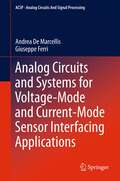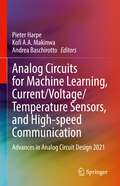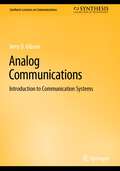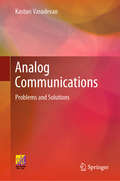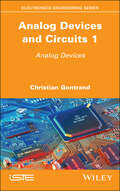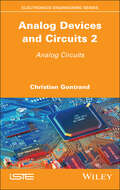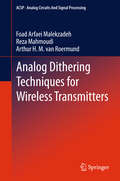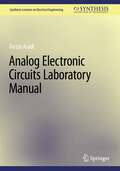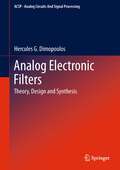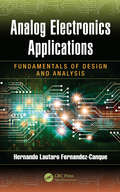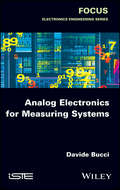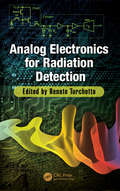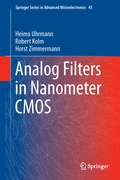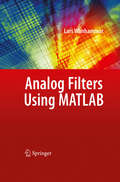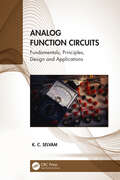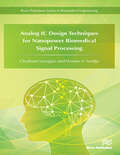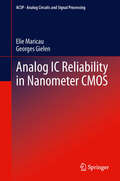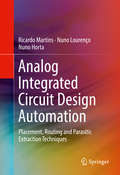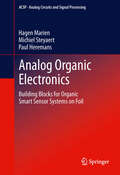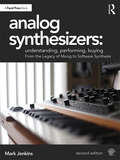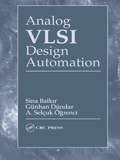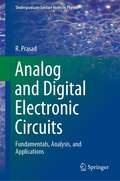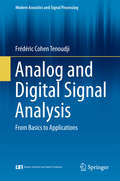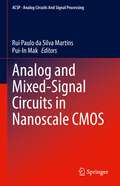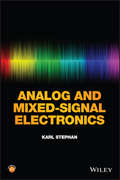- Table View
- List View
Analog Circuits and Systems for Voltage-Mode and Current-Mode Sensor Interfacing Applications (Analog Circuits and Signal Processing)
by Andrea De Marcellis Giuseppe FerriAnalog CMOS Microelectronic Circuits describes novel approaches for analog electronic interfaces design, especially for resistive and capacitive sensors showing a wide variation range, with the intent to cover a lack of solutions in the literature. After an initial description of sensors and main definitions, novel electronic circuits, which do not require any initial calibrations, are described; they show both AC and DC excitation voltage for the employed sensor, and use both voltage-mode and current-mode approaches. The proposed interfaces can be realized both as prototype boards, for fast characterization (in this sense, they can be easily implemented by students and researchers), and as integrated circuits, using modern low-voltage low-power design techniques (in this case, specialist analog microelectronic researchers will find them useful). The primary audience of Analog CMOS Microelectronic Circuits are: analog circuit designers, sensor companies, Ph.D. students on analog microelectronics, undergraduate and postgraduate students in electronic engineering.
Analog Circuits for Machine Learning, Current/Voltage/Temperature Sensors, and High-speed Communication: Advances in Analog Circuit Design 2021
by Kofi A. A. Makinwa Andrea Baschirotto Pieter HarpeThis book is based on the 18 tutorials presented during the 29th workshop on Advances in Analog Circuit Design. Expert designers present readers with information about a variety of topics at the frontier of analog circuit design, with specific contributions focusing on analog circuits for machine learning, current/voltage/temperature sensors, and high-speed communication via wireless, wireline, or optical links. This book serves as a valuable reference to the state-of-the-art, for anyone involved in analog circuit research and development.
Analog Communications: Introduction to Communication Systems (Synthesis Lectures on Communications)
by Jerry D. GibsonThis book develops the basic concepts in understanding Analog Communications. Beginning with coverage of amplitude modulation, including the time and frequency domain representations of double sideband, single sideband, and vestigial sideband modulation, and introduces the student to the fundamental ideas of quadrature amplitude modulation, frequency division multiplexing, and digital communications using on-off keying. The author continues with additional discussion and coverage of the time and frequency domain representations of frequency and phase modulation, including bandwidth calculations, and the use of frequency shift keying, phase shift keying, and differential phase shift keying for the transmission of digital information. Contents include applications and further analyses of the effects of channel noise on amplitude, phase, and frequency modulation performance based on input versus output signal to noise ratios and some system comparisons are discussed.
Analog Communications: Problems and Solutions
by Kasturi VasudevanThis textbook covers the fundamental concepts of analog communications with a Q&A approach. It is a comprehensive compilation of numerical problems and solutions covering all the topics in analog communications. Richly illustrated with figures, this book covers the important topics of signals and systems, random variables and random processes, amplitude modulation, frequency modulation, pulse code modulation and noise in analog modulation. It has numerical questions and their solutions clearing the concepts of Fourier transform, Hilbert transform, modulation, synchronization, signal-to-noise ratio analysis and many more. All the solutions have step-by-step approach for easy understanding. This book will be of great interest to the students of electronics and electrical communications engineering.
Analog Devices and Circuits 1: Analog Devices
by Christian GontrandAt the end of the Second World War, a new technological trend was born: integrated electronics. This trend relied on the enormous rise of integrable electronic devices. Analog Devices and Circuits is composed of two volumes: the first deals with analog components, and the second with associated analog circuits. The goal here is not to create an overly comprehensive analysis, but rather to break it down into smaller sections, thus highlighting the complexity and breadth of the field. This first volume, after a brief history, describes the two main devices, namely bipolar transistors and MOS, with particular importance given to the modeling aspect. In doing so, we deal with new devices dedicated to radio frequency, which touches on nanoelectronics. We will also address some of the notions related to quantum mechanics. Finally, Monte Carlo methods, by essence statistics, will be introduced, which have become more and more important since the middle of the twentieth century. The second volume deals with the circuits that "use" the analog components that were introduced in Volume 1. Here, a particular emphasis is placed on the main circuit: the operational amplifier.
Analog Devices and Circuits 2: Analog Circuits
by Christian GontrandAt the end of the Second World War, a new technological trend was born: integrated electronics. This trend relied on the enormous rise of integrable electronic devices. Analog Devices and Circuits is composed of two volumes: the first deals with analog components, and the second with associated analog circuits. The goal here is not to create an overly comprehensive analysis, but rather to break it down into smaller sections, thus highlighting the complexity and breadth of the field. This first volume, after a brief history, describes the two main devices, namely bipolar transistors and MOS, with particular importance given to the modeling aspect. In doing so, we deal with new devices dedicated to radio frequency, which touches on nanoelectronics. We will also address some of the notions related to quantum mechanics. Finally, Monte Carlo methods, by essence statistics, will be introduced, which have become more and more important since the middle of the twentieth century. The second volume deals with the circuits that "use" the analog components that were introduced in Volume 1. Here, a particular emphasis is placed on the main circuit: the operational amplifier.
Analog Dithering Techniques for Wireless Transmitters (Analog Circuits and Signal Processing #3)
by Reza Mahmoudi Foad Arfaei Malekzadeh Arthur H.M. RoermundThis book describes innovative techniques and the theoretical background for design and analysis of high performance RF/Microwave transmitters. It introduces new, robust linearization/efficiency enhancement techniques, applicable to all of the switched mode power amplifiers. Novel analysis methods associated with these new techniques are also introduced and supporting measurement results are documented. Innovative graphical representation methods are used to help the reader understand the matter intuitively. Applications for the techniques discussed are very extensive, ranging from data convertors to RF/Microwave/mm-wave wireless/wire line transmitters. The authors have avoided using lengthy formulas in the discussion and have used an intuitive and simple approach to go through the necessary details. Readers will gain valuable understanding of the dither phenomenon, its mechanism, effect and undesired side effects. The novel architectures introduced are simple, don't require complicated DSP techniques and are easy to implement.
Analog Electronic Circuits Laboratory Manual (Synthesis Lectures on Electrical Engineering)
by Farzin AsadiThis is a book for a lab course meant to accompany, or follow, any standard course in electronic circuit analysis. It has been written for sophomore or junior electrical and computer engineering students, either concurrently with their electronic circuit analysis class or following that class. This book is appropriate for non-majors, such as students in other branches of engineering and in physics, for which electronic circuits is a required course or elective and for whom a working knowledge of electronic circuits is desirable. This book has the following objectives: 1. To support, verify, and supplement the theory; to show the relations and differences between theory and practice. 2. To teach measurement techniques. 3. To convince students that what they are taught in their lecture classes is real and useful. 4. To help make students tinkerers and make them used to asking “what if” questions.
Analog Electronic Filters: Theory, Design and Synthesis (Analog Circuits and Signal Processing)
by Hercules G. DimopoulosFilters are essential subsystems in a huge variety of electronic systems. Filter applications are innumerable; they are used for noise reduction, demodulation, signal detection, multiplexing, sampling, sound and speech processing, transmission line equalization and image processing, to name just a few. In practice, no electronic system can exist without filters. They can be found in everything from power supplies to mobile phones and hard disk drives and from loudspeakers and MP3 players to home cinema systems and broadband Internet connections. This textbook introduces basic concepts and methods and the associated mathematical and computational tools employed in electronic filter theory, synthesis and design. This book can be used as an integral part of undergraduate courses on analog electronic filters. Includes numerous, solved examples, applied examples and exercises for each chapter.Includes detailed coverage of active and passive filters in an independent but correlated manner.Emphasizes real filter design from the outset.Uses a rigorous but simplified approach to theoretical concepts and reinforces understanding through real design examples.Presents necessary theoretical background and mathematical formulations for the design of passive and active filters in a natural manner that makes the use of standard tables and nomographs unnecessary and superfluous even in the most mystifiying case of elliptic filters.Uses a step-by-step presentation for all filter design procedures and demonstrates these in numerous example applications. .
Analog Electronics Applications: Fundamentals of Design and Analysis
by Hernando Lautaro Fernandez-CanqueThis comprehensive text discusses the fundamentals of analog electronics applications, design, and analysis. Unlike the physics approach in other analog electronics books, this text focuses on an engineering approach, from the main components of an analog circuit to general analog networks. Concentrating on development of standard formulae for conventional analog systems, the book is filled with practical examples and detailed explanations of procedures to analyze analog circuits. The book covers amplifiers, filters, and op-amps as well as general applications of analog design.
Analog Electronics for Measuring Systems
by Davide BucciMany instrumentation engineers and scientists often deal with analog electronic issues when approaching delicate measurements. Even if off-the-shelf measuring solutions exist, comprehension of the analog behavior of the measuring system is often a necessity. This book provides a concise introduction to the main elements of a low frequency analog acquisition chain. It aims to be sufficiently general to provide an introduction, yet specific enough to guide the reader through some classical problems that may be encountered in the subject. Topics include sensors, conditioning circuits, differential and instrumentation amplifiers, active filters (mainly for anti-aliasing purposes) and analog to digital converters. A chapter is devoted to an introduction to noise and electronic compatibility.This work is intended for people with a general background in electronics and signal processing, who are looking for an introduction to classical electronic solutions employed in measuring instruments involving low frequency analog signal processing.
Analog Electronics for Radiation Detection (Devices, Circuits, and Systems)
by Renato TurchettaAnalog Electronics for Radiation Detection showcases the latest advances in readout electronics for particle, or radiation, detectors. Featuring chapters written by international experts in their respective fields, this authoritative text: Defines the main design parameters of front-end circuitry developed in microelectronics technologies Explains the basis for the use of complementary metal–oxide semiconductor (CMOS) image sensors for the detection of charged particles and other non-consumer applications Delivers an in-depth review of analog-to-digital converters (ADCs), evaluating the pros and cons of ADCs integrated at the pixel, column, and per-chip levels Describes incremental sigma–delta ADCs, time-to-digital converter (TDC) architectures, and digital pulse-processing techniques complementary to analog processing Examines the fundamental parameters and front-end types associated with silicon photomultipliers used for single visible-light photon detection Discusses pixel sensors with per-pixel TDCs, channel density challenges, and emerging 3D technologies interconnecting detectors and electronics Thus, Analog Electronics for Radiation Detection provides a single source for state-of-the-art information on analog electronics for the readout of radiation detectors.
Analog Filters in Nanometer CMOS (Springer Series in Advanced Microelectronics #45)
by Robert Kolm Heimo Uhrmann Horst ZimmermannStarting from the basics of analog filters and the poor transistor characteristics in nanometer CMOS 10 high-performance analog filters developed by the authors in 120 nm and 65 nm CMOS are described extensively. Among them are gm-C filters, current-mode filters, and active filters for system-on-chip realization for Bluetooth, WCDMA, UWB, DVB-H, and LTE applications. For the active filters several operational amplifier designs are described. The book, furthermore, contains a review of the newest state of research on low-voltage low-power analog filters. To cover the topic of the book comprehensively, linearization issues and measurement methods for the characterization of advanced analog filters are introduced in addition. Numerous elaborate illustrations promote an easy comprehension. This book will be of value to engineers and researchers in industry as well as scientists and Ph.D students at universities. The book is also recommendable to graduate students specializing on nanoelectronics, microelectronics or circuit engineering.
Analog Filters using MATLAB
by Lars WanhammarThis textbook provides a complete introduction to analog filters for senior undergraduate and graduate students. It covers the synthesis of analog filters as well as many other filter types including passive filters and filters with distributed elements. The material also addresses the basic circuit elements for the filters. Each chapter contains examples as well as problems and the author also provides a list of MATLAB functions.
Analog Function Circuits: Fundamentals, Principles, Design and Applications
by K. C. SelvamThis textbook comprehensively presents different types of analog function circuits and outlines the function circuit types implemented with lowpass filters, peak detectors, and sample and hold circuits. The text analyzes the complete architecture of a function circuit, identifies the applications of op-amps for performing a function circuit, and explores new ways of deriving function circuits using a sawtooth wave generator and a triangular wave generator. It covers important topics including waveform generators, analog dividers, time division multipliers-cum-dividers (MCDs), peak responding MCDs, vector magnitude circuits, multifunction converters, and phase sensitive detector circuits. The textbook will serve as an ideal study material for senior undergraduate and graduate students in the fields of electrical, electronics, and communications engineering. The textbook is accompanied by teaching resources, including a solutions manual for instructors.
Analog IC Design Techniques for Nanopower Biomedical Signal Processing (River Publishers Series In Biomedical Engineering Ser.)
by Wouter A. Serdijn Chutham SawigunAs the requirements for low power consumption and very small physical dimensions in portable, wearable and implantable medical devices are calling for integrated circuit design techniques using MOSFETs operating in the subthreshold regime, this book first revisits some well-known circuit techniques that use CMOS devices biased in subthreshold in order to establish nanopower integrated circuit designs. Based on the these findings, this book shows the development of a class-AB current-mode sample-and-hold circuit with an order of magnitude improvement in its figure of merit compared to other state-of-the-art designs. Also, the concepts and design procedures of 1) single-branch filters 2) follower-integrator-based lowpass filters and 3) modular transconductance reduction techniques for very low frequency filters are presented. Finally, to serve the requirement of a very large signal swing in an energy-based action potential detector, a nanopower class-AB current-mode analog multiplier is designed to handle input current amplitudes of more than 10 times the bias current of the multiplier circuit. The invented filter circuits have been fabricated in a standard 0.18 µ CMOS process in order to verify our circuit concepts and design procedures. Their experimental results are reported.
Analog IC Reliability in Nanometer CMOS (Analog Circuits and Signal Processing)
by Georges Gielen Elie MaricauThis book focuses on modeling, simulation and analysis of analog circuit aging. First, all important nanometer CMOS physical effects resulting in circuit unreliability are reviewed. Then, transistor aging compact models for circuit simulation are discussed and several methods for efficient circuit reliability simulation are explained and compared. Ultimately, the impact of transistor aging on analog circuits is studied. Aging-resilient and aging-immune circuits are identified and the impact of technology scaling is discussed. The models and simulation techniques described in the book are intended as an aid for device engineers, circuit designers and the EDA community to understand and to mitigate the impact of aging effects on nanometer CMOS ICs.
Analog Integrated Circuit Design Automation: Placement, Routing and Parasitic Extraction Techniques
by Nuno Horta Nuno Lourenço Ricardo MartinsThis book introduces readers to a variety of tools for analog layout design automation. After discussing the placement and routing problem in electronic design automation (EDA), the authors overview a variety of automatic layout generation tools, as well as the most recent advances in analog layout-aware circuit sizing. The discussion includes different methods for automatic placement (a template-based Placer and an optimization-based Placer), a fully-automatic Router and an empirical-based Parasitic Extractor. The concepts and algorithms of all the modules are thoroughly described, enabling readers to reproduce the methodologies, improve the quality of their designs, or use them as starting point for a new tool. All the methods described are applied to practical examples for a 130nm design process, as well as placement and routing benchmark sets.
Analog Organic Electronics: Building Blocks for Organic Smart Sensor Systems on Foil (Analog Circuits and Signal Processing)
by Hagen Marien Paul Heremans Michiel SteyaertThis book provides insight into organic electronics technology and in analog circuit techniques that can be used to increase the performance of both analog and digital organic circuits. It explores the domain of organic electronics technology for analog circuit applications, specifically smart sensor systems. It focuses on all the building blocks in the data path of an organic sensor system between the sensor and the digital processing block. Sensors, amplifiers, analog-to-digital converters and DC-DC converters are discussed in detail. Coverage includes circuit techniques, circuit implementation, design decisions and measurement results of the building blocks described.
Analog Synthesizers: From the Legacy of Moog to Software Synthesis
by Mark JenkinsMaking its first huge impact in the 1960s through the inventions of Bob Moog, the analog synthesizer sound, riding a wave of later developments in digital and software synthesis, has now become more popular than ever. Analog Synthesizers charts the technology, instruments, designers, and musicians associated with its three major historical phases: invention in the 1960s–1970s and the music of Walter Carlos, Pink Floyd, Gary Numan, Genesis, Kraftwerk, The Human League, Tangerine Dream, and Jean-Michel Jarre; re-birth in the 1980s–1990s through techno and dance music and jazz fusion; and software synthesis. Now updated, this new edition also includes sections on the explosion from 2000 to the present day in affordable, mass market Eurorack format and other analog instruments, which has helped make the analog synthesizer sound hugely popular once again, particularly in the fields of TV and movie music. Major artists interviewed in depth include: Hans Zimmer (Golden Globe and Academy Award nominee and winner, "Gladiator" and "The Lion King") Mike Oldfield (Grammy Award winner, "Tubular Bells") Isao Tomita (Grammy Award nominee, "Snowflakes Are Dancing") Rick Wakeman (Grammy Award nominee, Yes) Tony Banks (Grammy, Ivor Novello and Brit Awards, Genesis) Nick Rhodes (Grammy Award Winner, Duran Duran) and from the worlds of TV and movie music: Kyle Dixon and Michael Stein (Primetime Emmy Award, "Stranger Things") Paul Haslinger (BMI Film and TV Music Awards, "Underworld") Suzanne Ciani (Grammy Award Nominee, "Neverland") Adam Lastiwka ("Travelers") The book opens with a grounding in the physics of sound, instrument layout, sound creation, purchasing, and instrument repair, which will help entry level musicians as well as seasoned professionals appreciate and master the secrets of analog sound synthesis. Analog Synthesizers has a companion website featuring hundreds of examples of analog sound created using dozens of classic and modern instruments.
Analog VLSI Design Automation (Vlsi Circuits Ser.)
by Sina Balkir Günhan Dündar A. Selçuk ÖgrenciThe explosive growth and development of the integrated circuit market over the last few years have been mostly limited to the digital VLSI domain. The difficulty of automating the design process in the analog domain, the fact that a general analog design methodology remained undefined, and the poor performance of earlier tools have left the analog
Analog and Digital Electronic Circuits: Fundamentals, Analysis, and Applications (Undergraduate Lecture Notes in Physics)
by R. PrasadThis book introduces the foundations and fundamentals of electronic circuits. It broadly covers the subjects of circuit analysis, as well as analog and digital electronics. It features discussion of essential theorems required for simplifying complex circuits and illustrates their applications under different conditions. Also, in view of the emerging potential of Laplace transform method for solving electrical networks, a full chapter is devoted to the topic in the book. In addition, it covers the physics and technical aspects of semiconductor diodes and transistors, as well as discrete-time digital signals, logic gates, and combinational logic circuits. Each chapter is presented as complete as possible, without the reader having to refer to any other book or supplementary material. Featuring short self-assessment questions distributed throughout, along with a large number of solved examples, supporting illustrations, and chapter-end problems and solutions, this book is ideal for any physics undergraduate lecture course on electronic circuits. Its use of clear language and many real-world examples make it an especially accessible book for students unfamiliar or unsure about the subject matter.
Analog and Digital Signal Analysis: From Basics to Applications (Modern Acoustics and Signal Processing)
by Frédéric Cohen TenoudjiThis book provides comprehensive, graduate-level treatment of analog and digital signal analysis suitable for course use and self-guided learning. This expert text guides the reader from the basics of signal theory through a range of application tools for use in acoustic analysis, geophysics, and data compression. Each concept is introduced and explained step by step, and the necessary mathematical formulae are integrated in an accessible and intuitive way. The first part of the book explores how analog systems and signals form the basics of signal analysis. This section covers Fourier series and integral transforms of analog signals, Laplace and Hilbert transforms, the main analog filter classes, and signal modulations. Part II covers digital signals, demonstrating their key advantages. It presents z and Fourier transforms, digital filtering, inverse filters, deconvolution, and parametric modeling for deterministic signals. Wavelet decomposition and reconstruction of non-stationary signals are also discussed. The third part of the book is devoted to random signals, including spectral estimation, parametric modeling, and Tikhonov regularization. It covers statistics of one and two random variables and the principles and methods of spectral analysis. Estimation of signal properties is discussed in the context of ergodicity conditions and parameter estimations, including the use of Wiener and Kalman filters. Two appendices cover the basics of integration in the complex plane and linear algebra. A third appendix presents a basic Matlab toolkit for computer signal analysis. This expert text provides both a solid theoretical understanding and tools for real-world applications.
Analog and Mixed-Signal Circuits in Nanoscale CMOS (Analog Circuits and Signal Processing)
by Pui-In Mak Rui Paulo da Silva MartinsThis book provides readers with a single-source reference to the state-of-the-art in analog and mixed-signal circuit design in nanoscale CMOS. Renowned authors from academia describe creative circuit solutions and techniques, in state-of-the-art designs, enabling readers to deal with today’s technology demands for high integration levels with a strong miniaturization capability.
Analog and Mixed-Signal Electronics
by Karl StephanA practical guide to analog and mixed-signal electronics, with an emphasis on design problems and applications <P><P> This book provides an in-depth coverage of essential analog and mixed-signal topics such as power amplifiers, active filters, noise and dynamic range, analog-to-digital and digital-to-analog conversion techniques, phase-locked loops, and switching power supplies. Readers will learn the basics of linear systems, types of nonlinearities and their effects, op-amp circuits, the high-gain analog filter-amplifier, and signal generation. The author uses system design examples to motivate theoretical explanations and covers system-level topics not found in most textbooks. <P> * Provides references for further study and problems at the end of each chapter <P> * Includes an appendix describing test equipment useful for analog and mixed-signal work <P> * Examines the basics of linear systems, types of nonlinearities and their effects, op-amp circuits, the high-gain analog filter-amplifier, and signal generation <P> Comprehensive and detailed, Analog and Mixed-Signal Electronics is a great introduction to analog and mixed-signal electronics for EE undergraduates, advanced electronics students, and for those involved in computer engineering, biomedical engineering, computer science, and physics.<P> Advisory: Bookshare has learned that this book offers only partial accessibility. We have kept it in the collection because it is useful for some of our members. To explore further access options with us, please contact us through the Book Quality link on the right sidebar. Benetech is actively working on projects to improve accessibility issues such as these.
